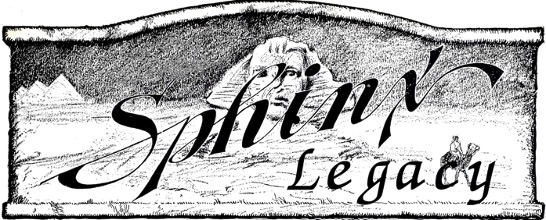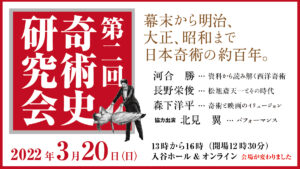“Sphinx Legacy” 編纂記 第49回
 加藤英夫
加藤英夫
‘Kuma Tube'(中華蒸籠)の名称の由来である、Kumaというマジシャンの名前が初めて”Sphinx”に現れたのは、1916年11月号においてでした。つぎのような短い一文です。
The same week The Kuma with Jack Innoway, billing themselves as the Aki Troupe, played the Olympic Theatre. Their act was exceptionally well received.
“Sphinx Legacy”では、Kumaはたびたび登場しますが、ここでは’Kuma Tube’について詳しく書かれている部分を紹介いたします。
以下は、David Priceが”A Pictorial History of Conjurers in the Theater”(1979年)に書いていることからの引用です。
One of the standard vaudeville acts in the United States over a long period of time was that of K. T. Kuma, a Japanese performer whose real name was said to be Kinjiro Tanko Kumajo. […] His equipment consisted of two cylinders about twelve inches in diameter and eighteen inches high. One cylinder nested inside the other. The tubes would be shown to be empty by holding them so that the audience could see through them and passing one through the other. In the process, Kuma threw the cylinders in the air and they would turn over in somersault fashion. He handled them so rapidly and expertly that, if there had been more than two, one would have said that he juggled them. At intervals the tubes would come to a stop and Kuma would produce objects from the seemingly empty tubes. He produced ladies’ shawls, Japanese lanterns, a live rabbit, and numerous other items. Finally, a large tub or pot of water was removed from one of the tubes. The water was poured into other vessels to establish that it was really water. Then Kuma tried to put the tub back into the tube, but it was obviously too big to go into the tube. At this point, the audience would be completely nonplussed. They had witnessed an impossibility. As paying customers recovered from shock, lines were let down from the flies and attached to something else emerged from the tubes. The silk was nearly as large as the front curtain and, when it was completely out of the tubes, the magician was momentarily out of the audience’s range of vision (behind the silk). However, it was only seconds later that Kuma stepped from behind the silk to take his bow and the audience discovered that he had made a complete change of clothing.
According to K. T. Kuma, he had first performed the tube trick in Japan in 1892. Born February 4, 1884, he had been apprenticed to a Japanese magician at age five. He came to the United States, he said, in 1904 to fulfill a three-year contract at a resort in California called Glen Island. The resort was not complete when he arrived and, to fill in the time, he was booked into the Orpheum theater in San Francisco. Then he went to Glen Island for one year, after which, he said, he obtained his relaease [sic] by buying off the remainder of the contact. In 1907 he worked in a Mexican circus, performing both magic and fire-eating.
K. T. Kuma found himself at the end of 1941 in a situation in which he was unable to book anything. The United States went to war with Japan and everything with a Japanese label was anathema to all Americans. Kuma proved himself equal to the occasion. Waving a wand over himself, the Japanese magician became a Korean magician named “Kim Yen Soo.” He remained Kim Yen Soo to the end of his life.
この文章の中で、”They had witnessed an impossibility”という文章は、どのような不思議なことかPriceは明記していませんが、壺につかえていた筒が「ストン」と落ちて、筒が消えたかのように見えること、そして筒から大きな布が現れることを意味していると思います。
‘中華蒸籠’というマジックは、私が子供のころから何回も見て、いちども不思議にも面白いとも思わなかったマジックです。外側の筒が空なのを見せて、それを内側の筒に重ねてから、内側の筒を抜いて空なのを見せるという、このマジックの根本的な’改め’のやり方が、まったく不思議を生み出すとは思えませんでした。
それでも見て素晴らしいと思ったマジシャンが1人だけいました。それは大阪の堀ジョージ師です。堀師の’中華蒸籠’は、何回も見させていただきました。なぜなら、松旭斎天洋師の金沢、富山公演において、堀師も私も出演したからです。
とにかく演技がスピーディでした。筒のハンドリングもジャグラーのように鮮やかでした。壺のカバーの外しとはめ込みも、もたもたやりませんでした。そして最後はテーブルの上に乗って立ち、布の陰で足先で密かに壺をスチールして、布をどけるとマジシャンが壺を抱えてポーズをとって終わります。
堀師の演技を思い出したので、他に変わった演じ方があるかどうか確かめたくて、YouTubeで数人の動画を見ました。どれも面白くありませんでしたが、Paul Danielsの演技だけは光り輝いていました。やはりDanielsは平凡なやり方などやりません。素晴らしいです。ぜひご覧になってください。
Danielsの演技では、最後に壺につっかえていた筒がストンと重なったあと、例の改めをやらないところが、他のマジシャンとは違います。その部分は不思議さを見せることよりも、アクトの’オチ’をつけることが狙いなのです。壺をある場所に隠しておいて、そこから出現させたあと、またその場所に隠して消えたように見せて終わるというのは、観客の疑念を証明するようなものです。
Kumaの演じ方でも、壺を消してから筒のあらためをやって終わるようなやり方はしていません。前述のDavid Priceの説明によると、壺につかえていた筒が「ストン」とはまったあと、筒の中から舞台を覆い尽くすような巨大な絹の布が出現されて、その陰から衣装チェンジしたKumaが現れて、ショーが締めくくられるというのです。
”Genii”,1954年4月号にRay Museによって、Kumaの演目が書かれていました。’中華蒸籠’の演技をクライマックスとする、全体の流れを知ることができます。
1. Song in “one” by girl assistant.
2. Production of girl assistant from three nested boxes.
3. “Asrah” levitation and vanish of girl.
4. Production of two girls from large cabinet.
5. Song in “one” by girl assistant.
6. Boy placed in large casket, which is taken apart. The boy has vanished but reappears after the casket has been re-assembled.
7. The Costume Trunk illusion.
8. Manipulation of two large leather tubes, producing large pot of water; placing it back in the tubes a large silk drop is hauled from tubes completely draping the front stage.
9. KUMA has worked all thru the act in dark dress suit. He emerges from behind the large silk in a complete change of costume; now dressed in white flannels, white shoes, straw hat and carrying a cane.NOTE: This act witnessed by the writer in 1921 at the Lyric Theater, Indianapolis, Ind., and headlined the bill. The effect with the two tubes, described in the Okito book, “Quality Magic,” and still being built to order by Abbott and the Owen’s Bros., could be a feature trick today and is worthy of revival.

“Genii”,1955年9月号より
KumaやPaul Danielsや堀ジョージは、マジックの終わり方についても、さすが一流マジシャンでありました。
(つづく)


